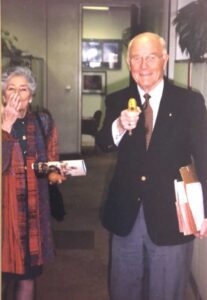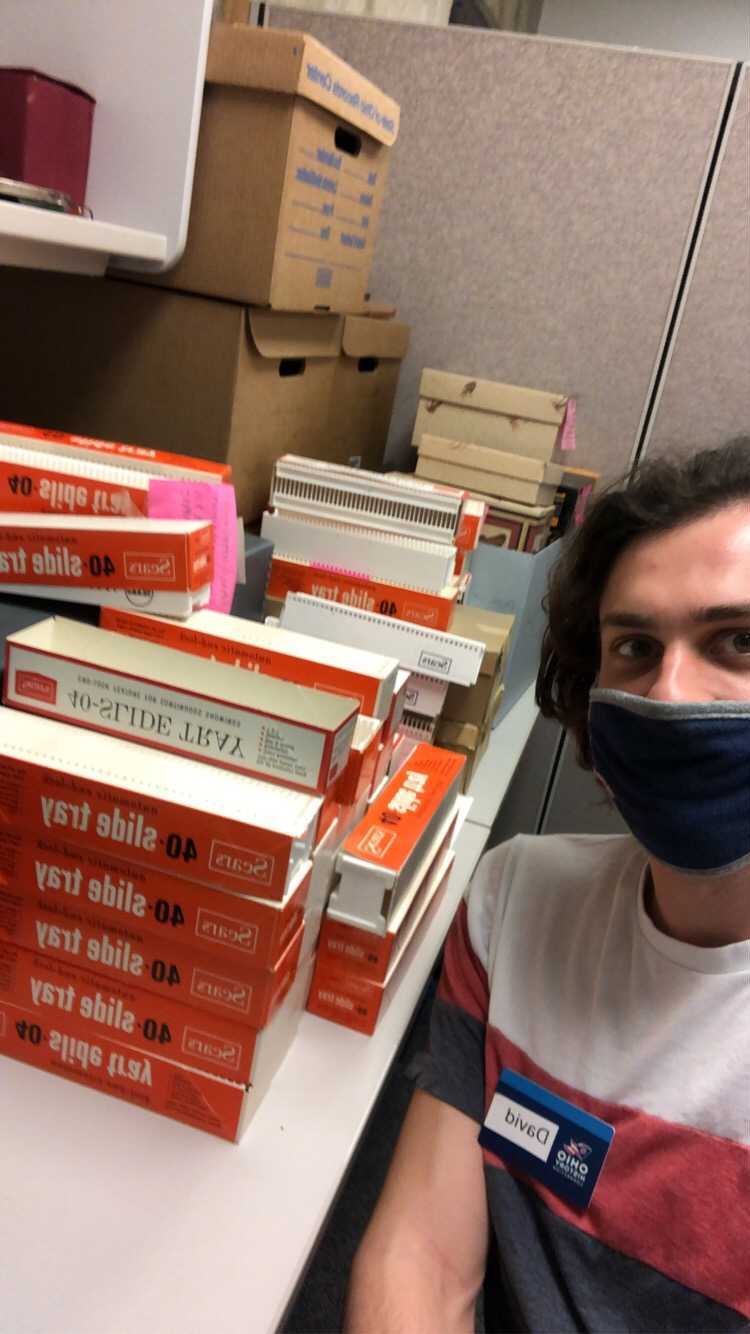Dining at Lazarus
Take a trip down memory lane and revisit some of the dining options that were once available at the Lazarus Department Store.
Hello everybody,
My name is David McDevitt, an intern here with the Ohio History Center’s manuscripts department. Perhaps you remember me from a few Ohio History blogs from years past? Well, I’m back in action after a long COVID-induced vacation, but this time I’m getting college credit for interning; I’m currently in my final year of grad school at Kent State, earning a master’s degree in Library and Information Science. Hopefully by this time next year I’ll have a full-time position at a museum or archives! This blog is an opportunity to start reflecting on my internship so far while tying this experience into the things I’ve been learning at school. When I returned to the OHC this summer, they put me back to work on the collection I’d been working with before everything shut down: MSS 628, the Prestige Concerts collection. Prestige Concerts was founded in 1948 in Columbus, Ohio, with the goal of bringing high quality chamber musicians (string quartets and such) to perform in our capital city. It has since gone through a couple name changes and is currently called Chamber Music Columbus.
It took a little while to reacquaint myself with the collection, which comprised something like 8-10 cubic feet of manuscripts that I hadn’t handled or seen in well over a year. I picked up where I left off and did my best to apply lessons I learned from school. I haven’t done any courses yet that address how to arrange and process collections, but I think I’ve picked up some useful tidbits from the classes I have taken. One concept taught in my class on archival appraisal (the practice of selecting and acquiring collections) is that we don’t accumulate collections just to have them. They need to be used, or at the very least be available for use. Otherwise, what’s the point?
Maybe I’m too much of a perfectionist, but since I first joined the Ohio History Connection five years ago (where does the time go?) I’ve found it very easy to get bogged down with little things when arranging collections. That might mean spending five minutes figuring out what to do with a single piece of paper or photograph, or sorting materials into a dozen different folders when three or four be more than adequate. But this summer I’ve come around to the idea that while thoroughness is important, I need to strike a balance between being meticulous and being quick. It would take forever to go through each collection with a fine-tooth comb and organize it in the most detailed manner possible. As my supervisor explained to me, it’s better to have two or three adequately processed collections than one that’s been painstakingly arranged. Like I touched on before, unprocessed and inaccessible collections are largely useless.
Additionally, something that has come up in past coursework has been the fact that a lot of cultural heritage institutions have significant backlogs of collections that need to be processed. In other words, we have to deal with the reality that there are a great many collections that deserve to be preserved and shared, but often not a great many staff to actually make them accessible. As a result, we cut corners where we can in order to produce the optimal balance of quality and quantity.
For example, in my recent work with Prestige Concerts, I found myself simply putting most of the organizations’ financial records in a few folders titled “Financial Records” without regard for date or details. Besides just trying to be speedy, I did this because certain parts of collections deserve more attention than others. In the case of Prestige Concerts, my supervisor told me that the collection’s users are mostly interested in concert programs, while more mundane things (such as financial or budgetary documents) are much less likely to be used. And if they are, they will still be available, but the researcher will just have to do a bit more digging to find what they’re looking for. To be clear, I don’t want to suggest that I’ve done a shoddy job this summer. I would instead say that I have started working smarter and more effectively to achieve the best overall results. In this case that means getting the collection processed, creating a finding aid online, and moving onto the next project.

My favorite picture of the Glenns! Photo credit: Ohio History Connection, The John and Annie Glenn collection
All that said, there are times to be meticulous. After finishing up with the Prestige Concerts collection, I was put to work on AV 329, the John and Annie Glenn collection. In case you’ve been living under a rock for the last 60 years, John Glenn was the first American to orbit the earth back in 1962. He went on to serve as a four-term senator from Ohio starting in 1975 until 1999. He’s an American hero and an all-time great Ohioan. If Ohio had a Mount Rushmore, John Glenn would probably be on it. Annie, while not nearly as well-known as John, was active as an advocate for Americans with disabilities.
The John and Annie Glenn collection is comprised of thousands of photographs and slides, with a relatively small number of accompanying ephemera and manuscripts. There are some materials that depict more traditionally “historical” images: John as a pilot in the Korean War, as an astronaut, and the Glenns on the campaign trail (John also ran for president in 1984). However, after processing most of the collection at the time of writing, I would say the majority is comprised of far more personal pictures. Hundreds upon hundreds of images depict the Glenns on vacation, their kids and grandkids, their boat, and even their cats. Many, particularly those from the Glenns’ vacations around the world, simply depict landscapes, locals, or tourist attractions rather than John or Annie themselves.
It’s of interest to me, although not altogether unsurprising, that we as an institution keep those images despite their seeming irrelevance to Ohio’s history. If John Glenn wasn’t a household name, we would likely retain the items of historical interest while returning the more personal materials to the Glenn family. But John Glenn IS a household name, and as a result the bar is lowered regarding what we collect pertaining to him and his life. Besides, as my supervisor explained, it can be worthwhile to retain candid, intimate pictures of famous people to humanize the public figure and show that they’re regular people too.
One other thing that I’m doing differently for the John and Annie Glenn collection is that I’m not fully processing it. As my supervisors explained to me, I’m doing an initial pass-through and roughly reorganizing the contents chronologically and by subject. That includes disposing of several trash bags full of empty slide containers and photo boxes that the collection materials arrived in. When I’m done with my internship, a permanent staff member will go over it all again and do a more thorough, precise job of it. In short, I need to tidy everything up and make it really easy for another archivist to revisit the collection.

Me with a bunch of empty slide and photo boxes from the John and Annie Glenn collection. Photo credit: David McDevitt
For example, most of the photographs came in envelopes from wherever the Glenns got their photos developed, e.g. Kodak. That envelope might have a brief descriptor, such as “China ’81. Rather than removing the photographs and individually sleeving them or interleaving them with acid-free paper, I simply put those envelopes in acid-free folders. The slides, however, arrived in boxes that couldn’t fit in folders, so I’ve been putting them into archival slide sleeves. That means I have to also copy the metadata written on the slide boxes onto the slide sleeves’ new folders; basically, I want to pass as much information about the collection materials as I possibly can onto the next archivist/manuscript curator to work on the collection.
It’s been really cool working with all these images of John Glenn’s family and career, and I’ve really enjoyed being back at the Ohio History Center this summer. Thanks for reading, and stay tuned for another (shorter, I promise) blog about John Glenn coming soon!